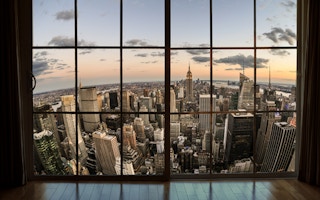Windows are a key component to any building’s design, so it’s only fitting that they are also an essential part of new strategies to improve energy efficiency. Windows impact the form and function of all rooms, and due to the heat transferred through the glass, windows have a significant impact on heating and cooling costs.
To continue reading, subscribe to Eco‑Business.
There's something for everyone. We offer a range of subscription plans.
- Access our stories and receive our Insights Weekly newsletter with the free EB Member plan.
- Unlock unlimited access to our content and archive with EB Circle.
- Publish your content with EB Premium.
Thankfully, a relatively new technology called smart glass allows architects to save energy without compromising design. As building codes around the United States increase demand for greener designs, smart glass windows have become less of a niche market technology and more of a product appealing to a variety of customers within the building sector.
Smart glass windows can automatically change their tint based on outdoor temperature and lighting conditions. This improves comfort levels for those inside the building and increases energy efficiency. For example, a heavy tint during summer months can reduce heat transfer from sunlight, reducing the need for cooler air conditioning.
The key feature of smart windows is a thin ceramic coating, which when activated by an electrical current will tint the glass. Though this process requires electricity, it is minimal when compared to the heating and cooling costs that can be saved. According to the National Renewable Energy Laboratory, powering about 100 windows worth of smart glass would require less power than a 75-watt light bulb.
“
Switching to smart windows could make a huge impact in the energy bills of today’s biggest buildings. Buildings account for almost 40 per cent of all energy consumption in the United States, according to the US Department of Energy
Significant and sustainable results
Smart glass windows are about 70 per cent more energy efficient during the summer season and 45 per cent more efficient in the winter compared to standard dual-pane glass. This reduces overall energy spending by approximately 25 per cent, according to window manufacturer Anderson Corporation.
Switching to smart windows could make a huge impact in the energy bills of today’s biggest buildings. Buildings account for almost 40 per cent of all energy consumption in the United States, according to the US Department of Energy. That means buildings use more than 40 quadrillion British thermal units of energy every year, a cost of more than US$400 billion. If these buildings could improve efficiency by 20 per cent by 2020, they could save more than US$40 billion.
Smart windows can provide even more savings in terms of the amount of greenhouse gas emissions that can be reduced. If every building in the United States installed smart glass windows, it would greatly decrease the amount of greenhouse gas emissions in the atmosphere. Not to mention, if less energy is demanded for building use, that means less energy needs to be sourced from foreign oil, reducing dependency.
Some major buildings have already installed smart windows and are seeing dramatic improvements in energy efficiency. In its first year after installation, the Empire State Building reported energy savings of US$2.4 million and cut carbon emissions by 4,000 metric tonnes, equivalent to planting 750 acres of pine forests. Additionally, this past January, the RiverCentre in St. Paul, Minnesota installed smart windows as part of its initiative to reduce its carbon footprint by 80 per cent in three years.
As part of a global initiative to reduce pollution and energy consumption, more and more businesses are seeking new ways to improve sustainability and efficiency, giving smart glass window technology an opportunity for continued growth. Clean energy market research firm Pike Research projects the smart glass market to reach US$700 million per year by 2020 and smart glass costs to fall 50 per cent by 2022 (current cost is around US$100 per square foot). Moving forward, smart windows are expected to become an architectural mainstay and a significant part of long-term energy-saving initiatives.
Paul Batistelli freelances in the energy field for the promotion of a greener society and energy means. He works to raise awareness on ecological issues, energy dependency and reducing carbon footprints.










